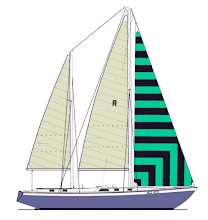http://fer3.com/arc/m2.aspx/Natural-Haversine-5-Place-Table-PDF-Rudzinski-jan-2017-g37790
Formula:
hvZD = n+[1-(n+m)](a)
Same Name
n = hv (L-d)
m = hv (L+d)
Contrary Name
n = hv (L+d)
m = hv (L-d)
L = Latitude
d = Declination
t = Meridian Angle
a = hv(t)
hv = Haversine
ZD = Zenith Distance
Hc = (90 - ZD) Calculated Altitude
Precision is 1' when done longhand to 4 places using natural haversines (see attached example). Azimuth is quickly done using the Ix graph (attached). A water resistant calculator watch such as the Casio CA 53W will make for ultra compact quick 5 place 0.1' precision as well as precise timing of observation. An Otis King slide rule will serve for quick non electronic 4 place precision.




Sir,
ReplyDeleteConcerning the Haversine Doniol method;
The Haversine tables I have only go to 180°. How is LHA treated when, for example, GHA of Venus is 36° and your Ap. Longitude is 85°? In this type of case is LHA simply 360° + (GHA Venus) minus Ap. Longitude. Then take that answer and subtract it from 360° to arrive at a 2 digit number?
Thank you,
Al
For GHA of 36 and assumed longitude 85 west use the meridian angle of 49 degrees to enter your tables. An older copy of Bowditch will have haversine tables that can be entered with LHA.
ReplyDeleteCan you provide a link to the tables online?
ReplyDeleteAl
Click on the Title for a Link to a complete haversine table. Print out for future use. You can also drag this link:
ReplyDeletehttp://fer3.com/arc/m2.aspx/Haversine-how-derive-it-Bernecky-jun-2015-g31663